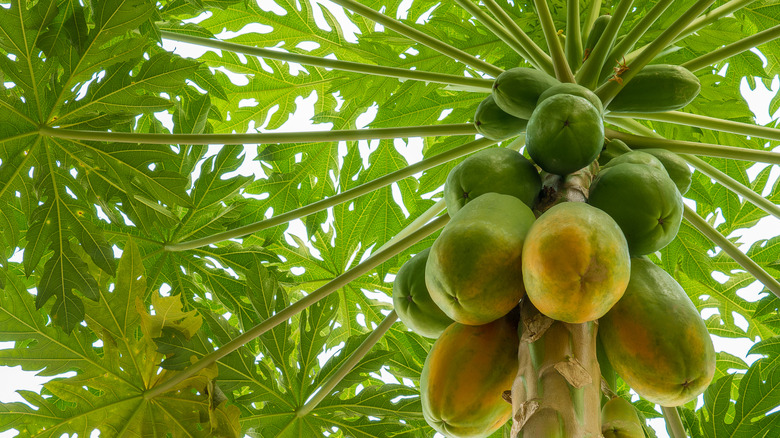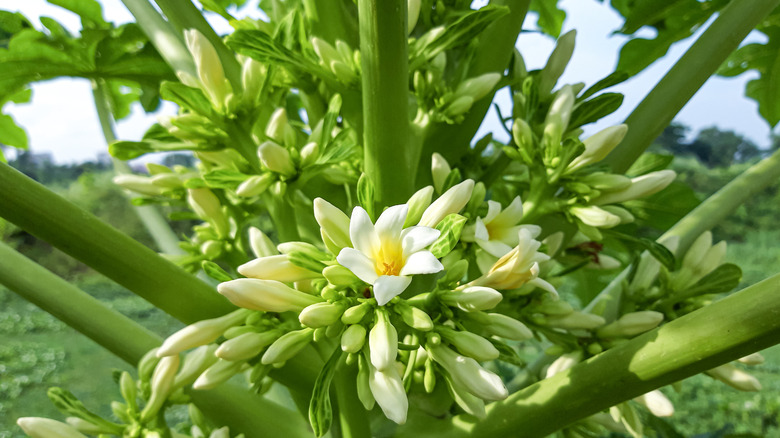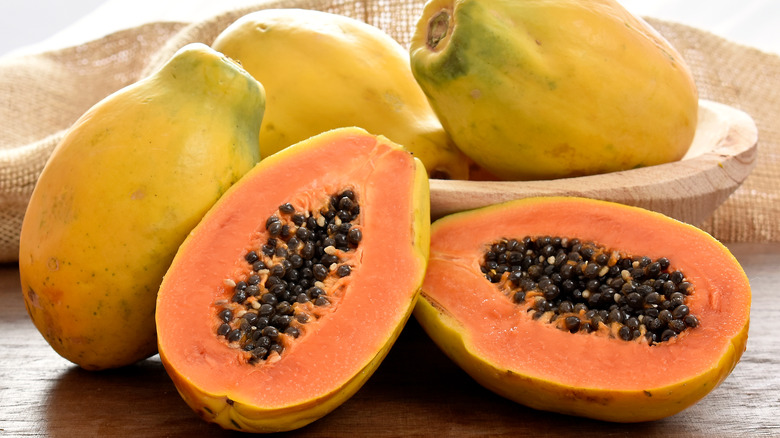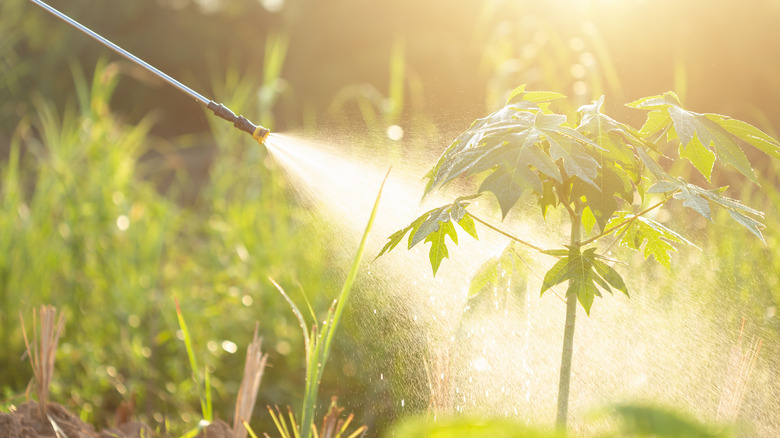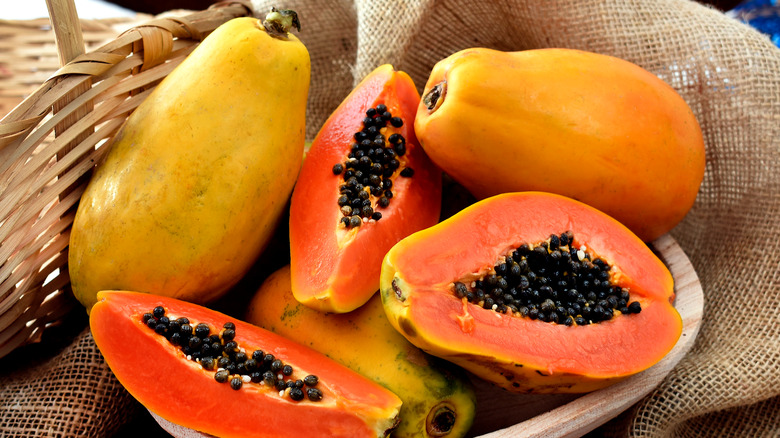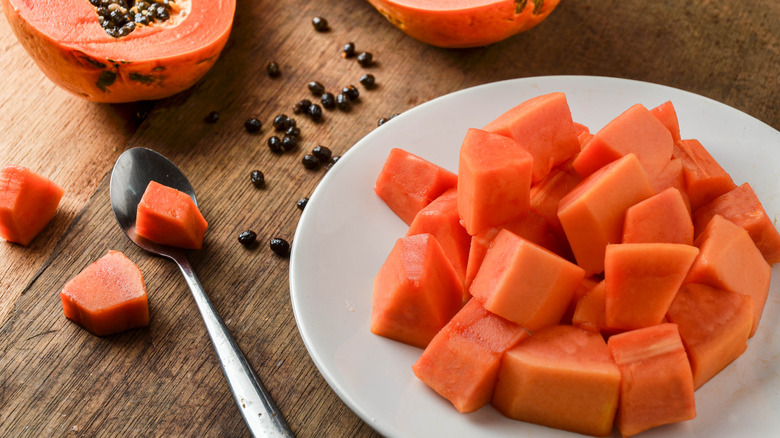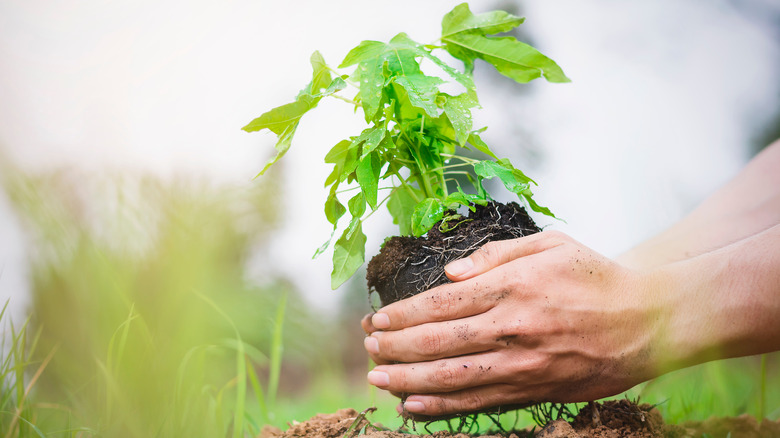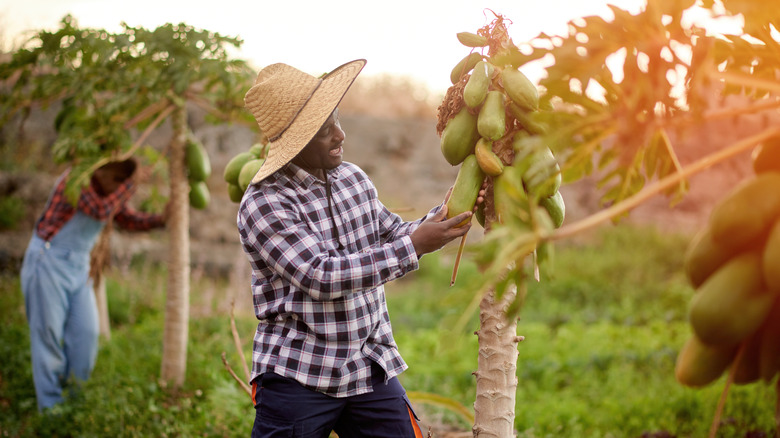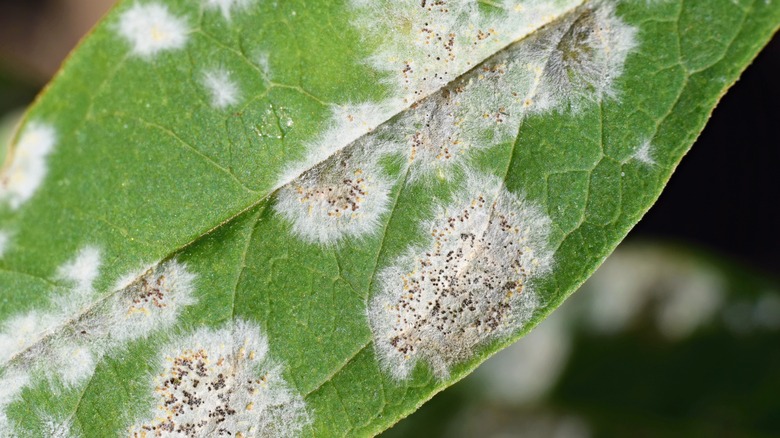How To Successfully Grow A Papaya Tree
Once a rare gem, papayas have grown in abundance and popularity throughout the United States. Not only are these fruits delicious, but they also have a proven variety of health benefits. Medical News Today states that papayas are a fantastic source of vitamin C and have a low calorie count, reinforcing their other benefits. They support your digestive tract and help against diabetes and high blood pressure. Papayas also can control blood glucose levels and are said to prevent heart disease and cancer. On top of everything else, eating papaya can speed up and assist a body's healing processes.
Papaya trees are native to Central America, thriving in the tropical environment. They grow best in warm and sunny environments but away from too much water. Like palm trees, papaya trees have a long, single-stemmed trunk with a crown of leaves and fruit at the top. However, Tropical Permaculture states that although papaya trees are quick and easy to grow, they are not as easy to keep alive. So, if you're ready to take steps to grow and keep your papaya tree alive, House Digest is here to help you do it.
How to use in garden
Papaya trees are a great way to add an edible touch to your garden quickly because they grow and can bear fruit within only a year of being planted. Papaya trees, with their graphic foliage and unique form, can be planted anywhere in the garden as they do not compete with other plants. Except for their fruits, these trees serve no purpose in the garden other than to look pretty. Female and unisex papaya trees produce the delicious, health-promoting fruit beloved by so many; on the other hand, the male papaya trees have leaves and flowers that can also be used as a culinary treat. When steamed, these tree parts can act as veggies to add to your dinner table.
The Kul Kul Farm also mentions that papaya stems make the perfect eco-friendly straws due to their thick, hollow stems. Simply rinse the sap from the stem piece and use it to sip on your favorite drinks; when you are finished using it, throw it in the compost. Once taken out of their jelly exterior, papaya seeds also act as an excellent substitute for black pepper when placed in a pepper grinder. Above all, papaya trees can add a unique and beautiful addition to any home garden.
How to grow a papaya tree
The National Department of Agriculture guides readers through the process of growing a papaya tree from its seeds. To mature your own papaya tree, you need to get the seeds inside the fruit: They are located at the center of the fruit and are surrounded by a jelly substance. Remove the seeds from their enclosure and let them dry before placing them in a tightly sealed container. You should plant papaya trees in December, so keep the seeds in the container until then. When ready to grow them, make a hole in a pot of soil and place five seeds together, leaving out compost or any other form of nutrition.
Finding the right spot in your garden is essential when growing a papaya tree. Because these trees are accustomed to tropical environments, they need a place in which they receive full sun. Gardening Know How also mentions keeping the papaya sheltered from harsh weather and specifically recommends planting the tree on your home's south or southeast side. Well-draining soil is also crucial for these plants due to their shallow roots and intolerance of soggy or wet conditions.
How to care for a papaya tree
Once your papaya tree has started growing, your next challenge is keeping the plant alive. Remember that papaya trees are tropical and subtropical plants: They thrive and can only survive in a warm environment, typically in the USDA zones 10 to 11. Cold environments, especially ones that drop below 32 degrees Fahrenheit, can cause damage or even kill the plant. To avoid this, keep the plant warm and ensure it receives a full amount of sunlight (per The Spruce).
Coming from a tropical environment, these plants also need plenty of water to survive. According to Edison and Ford Winter Estates, papaya trees have large leaves, but their leaves are also soft, which means they dehydrate very quickly. Especially when the weather is warmer, ensure the soil around your papaya tree remains moist, but never let water sit on the soil's surface or make the ground soggy. Because papaya trees are fast-growing, they also need plenty of fuel to assist their growth; therefore, ensure they are fertilized regularly and placed in nutrient-rich soil. Composted soil is highly recommended.
Papaya tree varieties
As papaya trees spread worldwide, various shrubs started to produce different fruit types. According to Home Stratosphere and Balcony Garden Web, the most common and noteworthy papaya tree varieties are:
- Hawaiian Sunset/Sunrise papaya — Also known as the Strawberry papaya because of the fruit's freckled skin, this variety is the most popular papaya tree in Hawaii because its fruit grows year-round.
- Mexican Red/Yellow papaya — Although this shrub is less sweet than other papaya fruits, it can grow up to 10 pounds heavy with fruit.
- Bettina papaya — This variety is mainly grown in Australia and is known for its very sweet flesh that contains little to no seeds.
- Guinea Gold papaya — Also native to Australia, these papayas have iconic yellow skin and flesh.
- Hortus Gold papaya — Bearing heavy 3 to 4 pound fruits, this variety is most commonly found in South Africa.
- Oak Leaved papaya — This type is a South American papaya that produces long, oval-shaped fruit with sweet, pulpy flesh.
- Samba papaya — This is the newest variety of papaya, introduced to produce markets in 2018, and has green-yellow skin with bright orange and sweet flesh on the inside.
- Royal Star papaya — This variety is a hybrid of the Mexican Red/ Yellow papaya created in Texas, with sweet and juicy fruit.
Is a papaya tree toxic?
Many parts of a papaya tree are not only edible but also act as a delicious culinary treat. However, Medical News Today warns that people with latex allergies should stay away from papaya because of the enzymes of the fruit that react similarly to latex. Papaya seeds are perfectly fine to ingest, though.
Your papaya tree's fruit can be a healthy treat for your dog; however, cats may be more susceptible to it due to their sensitive stomachs. Because papayas are high in fiber, they can be easily digested by cats, but too much can cause stomachaches. Moreover, aside from the fruit, ensure your animal companions do not ingest the papaya's seeds. The seeds can cause intestinal blockage, leading to severe stomach aches when eaten in large amounts because of the cyanide amount they contain, as per Citizen Canine. FAQ Cats also mentions avoiding sharing dried versions of the fruit with your pet due to the large amount of sugar it retains when dried.
How to repot a papaya tree
If you are using or growing your papaya tree as a potted plant on a balcony or porch, you may need to think about repotting your plant after a while. OrganicGarden Sage's YouTube channel recommends repotting your papaya tree in cooler weather and leaving as much original soil attached to the roots as possible. This method minimizes damage to your plant's root system and helps them thrive after being replanted.
Before transferring the plant to its new pot, ensure you fill the new pot with good draining soil and nutrients, like composted soil, to assist the future health of the plant. Once the plant has been transferred over to its new pot, thoroughly water it. You know the plant is well-saturated when water seeps out of the drainage holes at the bottom of the pot. As the roots heal from the pot transfer, keep the plant out of direct sunlight for a few days before placing it in its designated spot.
How to harvest a papaya tree
As your papaya tree begins to grow fruit, it is important to watch closely as its fruit ripens. If you planted your papaya tree from a seed, this process could occur as early as a year after the seed is germinated. Most papaya fruits have a green exterior that will turn yellow as it ripens, but the smell will attract animals and insects if you wait too long for the fruit to ripen on the tree.
To avoid this issue, pick the fruit as soon as yellow patches begin to form on the surface of the green fruit, GrowEverything's YouTube video, recommends. When you are ready to pick it, take the fruit gently in your hand and twist it until it snaps off the branch. After separating it from the tree, give the fruit a few days to ripen before cutting it open and digging in.
Common diseases of a papaya tree
Gardening Know How mentions that papaya trees are susceptible to diseases like powdery mildew and black spot. Powdery mildew is a whiteish-grey powdery substance that can form on several different tree parts. Although this disease cannot directly kill your plant, it can affect the growth of your tree. On the other hand, a black spot is a disease where small dark marks form on the leaves and fruit of your tree. Your plant most commonly contracts this disease during cool and damp weather.
The easiest way to cure a diseased papaya tree is through pruning. Gardening Know How recommends cutting off all the diseased parts of the tree and properly disposing of them. Also, ensure the tools you used to prune your diseased tree are properly cleaned, using bleach, before using them again. Sulfur and other copper-based fungicides can also kill off diseases on your papaya tree. However, if you want to prevent these diseases, simply keep your trees healthy with the right nutrients: These include potassium, magnesium, and phosphorus.
